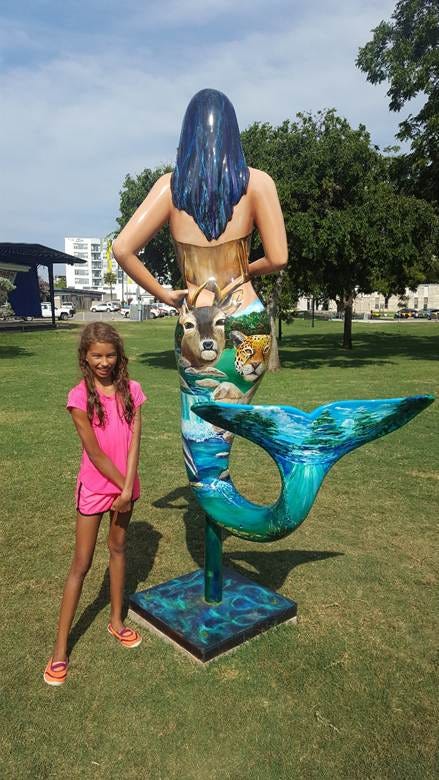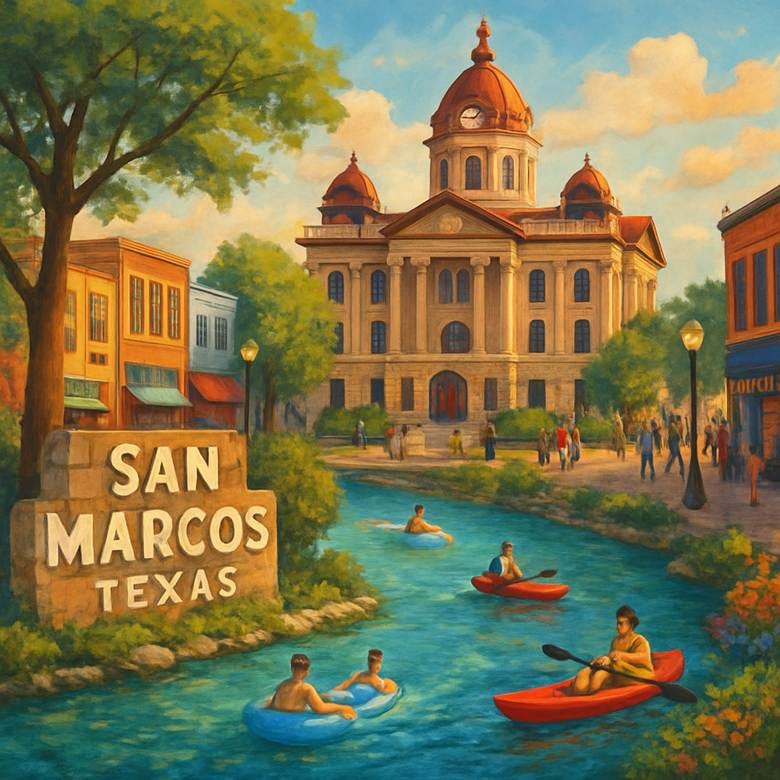Sense of place is “the emotive bonds and attachments people develop or experience in particular locations and environments.”[1] It can be used to describe the significant or distinguishing characteristics (positive or negative) of a locality, which is referred to as place identity. Accordingly, sense of place can be leveraged to influence decisions. My two previous posts on Blue Spaces for Blue Minds and Take Me to the River are examples of how the unique traits and multidimensional values of the San Marcos River have been used for stewardship of this precious place. Indeed, the sense of place provided by the San Marcos River emanates through all cultural aspects of the town. Two years ago, Texas State University used this sense of place to rebrand itself as River State. It was a good idea in principle, but where they fell flat was charging $40 for a t-shirt, not giving any of the profits back to the river, and not consulting with any of the river stewards before unveiling their marketing campaign. If they had consulted with river stewards, they would have realized what a bad idea it is to sell can koozies for a river with a can ban. River State was a missed opportunity.
The City of San Marcos has also used the river’s sense of place for branding, as well as tourism marketing and stewardship. The mascot that the City chose to foster sense of place is the mermaid. And as of 2021, San Marcos is officially the Mermaid Capital of Texas. Mermaids have a rich history in San Marcos, dating back to 1951 with the opening of Aquarena amusement park and its featured underwater attraction, the Aquamaids.[2] The Aquamaids did not anatomically become mermaids until the 1970s when fish tails were added, but that was a technicality marketers and tourists overlooked. The Aquamaids were so popular that Aquarena (later Aquarena Springs) was the most visited tourist attraction in all of Texas during the 1950s and 1960s. The amusement park closed in 1996 and the mermaids moved downstream, but a sense of place had been established. This mermaid culture was reenergized in the 2010s, largely by the efforts of July (Moreno) Holbrook.[2] July, born and raised in San Marcos, moved back to her hometown in 2011. “Acutely aware of the city’s rampant growth” and its potential impact on her beloved river, July joined the San Marcos Arts Commission, which in 2016 commissioned the mural at the top of this post—Dive Into the Divine, which greets visitors as they enter downtown and brings awareness to the river ecosystem’s Beautiful inhabitants, including the mermaid. 2016 was a watershed year because that is when July (Moreno) Holbrook founded the Mermaid Society of Texas and organized the SPLASH Festival, an acronym for Stewardship, Preservation, Local, Arts, Sustainability, and Heritage. This 15-day festival consisted of dozens of events, including the first annual Mermaid Parade. The Mermaid Society and Mermaid Parade have been going strong since, enhancing San Marcos’ sense of place, creative advocacy, and stewardship culture.
One of my earliest memories of the San Marcos River was taking my daughter Aaralyn, when she was 6 years old, to meet a real-life mermaid at City Park. I do not know what Aaralyn thought about this mythical creature at the time (she was probably awestruck), but my environmental geographer brain realized the brilliance of this interaction. I know not everyone appreciates the importance of a healthy river ecosystem, especially little kids. But if a 6-year-old sees the river as the mermaid’s home, they will think twice about trashing this special place. To this day, Aaralyn has never trashed the San Marcos River, or any river for that matter. In fact, she periodically participates in river clean-ups. Maybe I had a hand in Aaralyn’s stewardship mindset, or maybe it was the mermaid. A few years after Aaralyn’s first mermaid encounter, the San Marcos Arts Commission created a Mermaid March—a self-guided tour around the city of ten 7-foot mermaid statues painted by regional artists. Being an artist herself, Aaralyn was eager to see all ten statues and have her photo taken with them. Two of these photos are below. By displaying beautiful mermaids around the city (not just by the river), the City took sense of place to another level. In addition to these statues, you can find mermaids all around San Marcos in murals, mini-murals, and sometimes in real life.

Using mermaids for the stewardship of blue spaces is not unique to San Marcos. In my travels to rivers around the world, I have encountered many mermaids. In Aotearoa New Zealand, there is a mermaid sightings database, and they are featured in the country’s 100% Pure campaign. There is also the old Maori legend and statue of Pania of the Reef, a mermaid who fell in love with the son of a Maori chief and became human after marrying him. Sound familiar? While exploring Lithuania, I came across a mermaid statue overlooking the Vilnia River in the city of Vilnius. Her name is Užupis, which translates to a place beyond the river. The statues and stories of mermaids from around the world reflect the cultural landscapes and human-environment interactions in blue spaces.
Sneak Peek of Next Week
Many of us will be taking road trips for summer vacation. If you are like me, you look for interesting stops along the way. And by interesting, I mean historically significant. The historically significant attractions I will cover next week are old forts and the new amenities they provide.
Word of the Week
Most of my posts so far have covered my community of San Marcos and the Texas Hill Country. Next week I will travel beyond this region, but before I leave my community (conceptually), I want to define this keyword. Like my first post on Keywords, I turn to Williams’ Keywords (2015) and Bennett’s New Keywords (2005):
Community is a term derived from the concept of “the commons or common people, as distinguished from those of rank.”[3] It is generally used as “the warmly persuasive word to describe an existing set of relationships.”[3] It is also used to convey “a connection—such as kinship, cultural heritage, shared values and goals—felt to be more “organic” or “natural,” and therefore stronger and deeper, than a rational or contractual association of individuals, such as the market or the state.”[4] In this sense, Community is more immediate and more intimate than Society. Historically, community involved physical, face-to-face interaction. But now, virtual communities exist, which begs the question: have rapid industrialization, urbanization, consumerism, and virtual technologies weakened community or have they created a new type of community. I will address this issue in future posts.

Song of the Week
This week I wanted a song about a river that also captures sense of place. One that comes to mind is “The River” by Bruce Springsteen. Springsteen's music is deeply connected to his sense of place—the landscapes and communities of New Jersey, as well as the experiences of struggling, working-class Americans. His song “The River” tells the true story of how a young couple’s hopes and dreams (those of his sister and brother-in-law) are crushed by socioeconomic circumstances. The river in this song represents a refuge from life’s struggles. It is a physical place you go to escape the daily grind, and it is also a mental place where your fond memories and hopes for the future flow. Unfortunately, Springsteen’s river went dry. Let’s hope that our river never dries up. But let’s also be good stewards and be proactive to ensure it keeps flowing.
[1] Foote and Azaryahu (2009), Sense of Place, In Kitchin and Thrift (Eds), International Encyclopedia of Human Geography, pp. 96-100.
[2] Oatman-Stanford (2013), The Real Mermaids of San Marcos, Texas, Collectors Weekly, September, https://www.collectorsweekly.com/articles/the-real-mermaids-of-san-marcos-texas/.
Hollern (2021), The Famous Mermaids of San Marcos, Austin Monthly, June, https://www.austinmonthly.com/the-famous-mermaids-of-san-marcos/.
[3] Williams (2015), Keywords: A Vocabulary of Culture and Society, p. 39.
[4] Bennett, Grossberg, and Morris (2005), New Keywords, p. 51.









